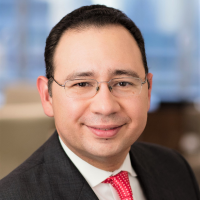EB5 Investors Magazine is pleased to announce the Top 15 Corporate and Securities Attorneys. To be eligible, distinguished attorneys needed to primarily draft offering documents for EB-5 financing.
For more information or to contact any of these professionals, we invite you to view their listings at www.EB5Investors.com/directories.
MICHAEL BAILKIN
 Michael Bailkin is a counsel to Akerman LLP, where he is the Co-Chair of its Opportunity Zone Practice Group. He specializes in economic development, both as a lawyer and developer. He previously served as a senior Economic Development official in New York City and was responsible for creating their initial incentive programs. In private practice, he has been responsible for securing over $3 billion in incentives. He also serves as an adviser and project manager for EB-5 projects. A key approach for him has been integrating EB-5 investments with a broad range of local, state and federal grants and loans.
Michael Bailkin is a counsel to Akerman LLP, where he is the Co-Chair of its Opportunity Zone Practice Group. He specializes in economic development, both as a lawyer and developer. He previously served as a senior Economic Development official in New York City and was responsible for creating their initial incentive programs. In private practice, he has been responsible for securing over $3 billion in incentives. He also serves as an adviser and project manager for EB-5 projects. A key approach for him has been integrating EB-5 investments with a broad range of local, state and federal grants and loans.
WHAT TRENDS ARE YOU SEEING IN THE EB-5 INDUSTRY?
An important trend in the industry is the use of EB-5 capital for projects in distressed areas that directly address poverty and provide real benefits for area residents. Until recently, most EB-5 funds were invested in high-end market areas. This is because it was relatively easy to obtain TEA (Targeted Employment Areas) status for those areas, and investors preferred those areas as long as they could get the TEA advantages. This also resulted in a few national developers controlling most of the EB-5 activity. Under current TEA rules, investors will be effectively limited to impacted areas, and the key to developers obtaining EB5 capital is to enhance feasibility conditions.
HOW ARE YOU HANDLING THE ISSUE OF REDEPLOYMENT?
Currently, legal rules and market conditions relating to redeployment are in flux. There is a need to recirculate EB-5 capital to enable a second round of job and investment impact, and to do so in a manner that fairly distributes the benefits/costs. But the rules need clarification and the high rates sought by Regional Centers deploying capital has dampened demand. In any case, the most important goal generally is to increase the level of EB-5 capital for new projects at a time when the key market, China, has basically shut down.
ROGELIO CARRASQUILLO
 Rogelio “Roy” Carrasquillo is the Managing Shareholder of Carrasquillo Law Group P.C. and Chair of its EB-5 Immigrant Investor Program Services and Compliance and Securities Practices. Carrasquillo represents public and private clients using EB-5 as a source of capital, filing for EB-5 Regional Center designation, investors evaluating their options at the redeployment stage, as well as developers seeking to raise capital using the EB-5 program. He is experienced with public-private partnership projects using EB-5 funds, Opportunity Zones and Tax Credits. He is a graduate of Georgetown University and University of Pennsylvania Law School and is admitted to practice in New York and Puerto Rico.
Rogelio “Roy” Carrasquillo is the Managing Shareholder of Carrasquillo Law Group P.C. and Chair of its EB-5 Immigrant Investor Program Services and Compliance and Securities Practices. Carrasquillo represents public and private clients using EB-5 as a source of capital, filing for EB-5 Regional Center designation, investors evaluating their options at the redeployment stage, as well as developers seeking to raise capital using the EB-5 program. He is experienced with public-private partnership projects using EB-5 funds, Opportunity Zones and Tax Credits. He is a graduate of Georgetown University and University of Pennsylvania Law School and is admitted to practice in New York and Puerto Rico.
WHAT TRENDS ARE YOU SEEING IN THE EB-5 INDUSTRY?
We saw a decrease in the number of new construction projects and developments, including those trying to incorporate EB-5 financing. We continue to see developers using EB-5 financing as an additional benefit and not as the sole purpose or financing source for their projects. We also continue to see an interest from Latin American EB-5 investors. We have also represented several groups of investors who are undergoing the liquidation or redeployment of their EB-5 investments to ensure that their rights are properly protected and that they are treated fairly during this process.
HOW ARE YOU HANDLING THE ISSUE OF REDEPLOYMENT?
We have been advising investors and developers on issues related to the redeployment of EB-5 capital. Although the new USCIS guidelines on redeployment provided much-needed guidance on the issue, they also implemented unexpected limitations such as the geographical location of the redeployment project. As more EB-5 projects reach maturity, investors find themselves trying to understand the corporate framework of their investment to ensure that their rights are protected during the process and to avoid unnecessary delays to the return of their investment. We have been working with these groups of investors to improve the transparency and help them navigate this process.
RONALD FIELDSTONE
 Ronald Fieldstone, chair of Saul Ewing Arnstein & Lehr LLP’s Global Immigration and Foreign Investment Group, and head of the Firm’s Opportunity Zone Group, practices primarily in the areas of corporate/securities and taxation law. Fieldstone has actively been serving as corporate/securities counsel for multifaceted industries involving EB-5 immigrant visa investor offerings. He represents developers and regional centers in EB-5 matters, currently handling more than 350 EB-5 projects with combined capital raise of nearly $8 billion. He frequently lectures on EB-5 corporate/securities for numerous government-sponsored organizations, industry groups and professional associations. Fieldstone graduated with a B.S., M.B.A., and J.D. from the University of Pennsylvania.
Ronald Fieldstone, chair of Saul Ewing Arnstein & Lehr LLP’s Global Immigration and Foreign Investment Group, and head of the Firm’s Opportunity Zone Group, practices primarily in the areas of corporate/securities and taxation law. Fieldstone has actively been serving as corporate/securities counsel for multifaceted industries involving EB-5 immigrant visa investor offerings. He represents developers and regional centers in EB-5 matters, currently handling more than 350 EB-5 projects with combined capital raise of nearly $8 billion. He frequently lectures on EB-5 corporate/securities for numerous government-sponsored organizations, industry groups and professional associations. Fieldstone graduated with a B.S., M.B.A., and J.D. from the University of Pennsylvania.
WHAT TRENDS ARE YOU SEEING IN THE EB-5 INDUSTRY?
This is a very complicated question. A few positives: New administration that is much more user friendly. Easier to get TEA designation due to COVID19 and different methods for economists to determine a TEA classification. In certain markets with a more friendly administration there is an increased demand for the EB5 visa. The headwinds are the June 30 sub-setting, new proposed legislation that now has IIUSA support that creates many difficulties, barriers and cost increase although it does greatly improve integrity measures. The consular delays due to COVID is also a major problem.
HOW ARE YOU HANDLING THE ISSUE OF REDEPLOYMENT?
With great care. We tear it like a new offering whether or not investor consent needs to be obtained. We emphasize independent appraisals or feasibility studies to support the financial assumptions and independence in the loan or equity administration. Also require a detailed immigration update to reflect all the changes over the past 20 months.
CATHERINE DEBONO HOLMES
 Catherine D. Holmes is Chair of JMBM’s Investment Capital Law Group, and the author of the Investment Law Blog. She has practiced law at JMBM for over 35 years, focusing on investment capital and business transactions. Holmes helps clients worldwide to raise, invest and manage capital from U.S. and non-U.S. investors. She has represented more than 100 real estate developers in obtaining financing through the EB-5 immigrant investor visa program, and has represented numerous Chinese investors. Her finance and investment experience includes handling business formations for entrepreneurs, private securities offerings, structuring and offering of private investment funds, and business and regulatory matters for investment bankers, investment advisers, securities broker-dealers and real estate/mortgage brokers.
Catherine D. Holmes is Chair of JMBM’s Investment Capital Law Group, and the author of the Investment Law Blog. She has practiced law at JMBM for over 35 years, focusing on investment capital and business transactions. Holmes helps clients worldwide to raise, invest and manage capital from U.S. and non-U.S. investors. She has represented more than 100 real estate developers in obtaining financing through the EB-5 immigrant investor visa program, and has represented numerous Chinese investors. Her finance and investment experience includes handling business formations for entrepreneurs, private securities offerings, structuring and offering of private investment funds, and business and regulatory matters for investment bankers, investment advisers, securities broker-dealers and real estate/mortgage brokers.
WHAT TRENDS ARE YOU SEEING IN THE EB-5 INDUSTRY?
The ability of U.S. project developers to use the EB-5 investment program to raise capital continues to suffer from long waiting periods for all EB-5 investors, and particularly those from China, as well as from the substantial increase in the minimum investment amount and changes in targeted employment requirements. EB-5 investors continue to seek only projects in targeted employment areas that qualify for the lower minimum investment amount. Although there are some projects being marketed at the higher minimum investment amount, they are not attracting much investor interest. This means that the number of projects that are able to raise financing under the EB-5 program has been significantly reduced.
HOW ARE YOU HANDLING THE ISSUE OF REDEPLOYMENT?
USCIS continued to disrupt the EB-5 program with its latest pronouncement that redeployments must be made only in the geographic area of the regional center that sponsored the original project. This has made redeployment more difficult for EB-5 investment funds. Some EB-5 investors from mainland China would prefer to withdraw their visa petitions and receive a return of their capital rather than redeploying. Even though an NCE is usually not contractually required to repay those withdrawing EB-5 investors, the NCE should consider using the proceeds of repayment of their initial investment to repay the withdrawing EB-5 investors.
MICHAEL HOMEIER
 In solo practice, Michael G. Homeier continues practicing securities, corporate, and business transactional law in Los Angeles as he did with Homeier Law PC, now emphasizing more individualized expert service for select clients. In his 13 years of EB-5 practice, Homeier has represented clients on literally hundreds of different projects large and small, primarily regional center and also direct, helping them successfully raise billions of dollars (creating thousands of jobs), while simultaneously working to influence positive policy changes and common-sense integrity reforms. He earned his J.D. from the University of Southern California and his B.A. from UCLA.
In solo practice, Michael G. Homeier continues practicing securities, corporate, and business transactional law in Los Angeles as he did with Homeier Law PC, now emphasizing more individualized expert service for select clients. In his 13 years of EB-5 practice, Homeier has represented clients on literally hundreds of different projects large and small, primarily regional center and also direct, helping them successfully raise billions of dollars (creating thousands of jobs), while simultaneously working to influence positive policy changes and common-sense integrity reforms. He earned his J.D. from the University of Southern California and his B.A. from UCLA.
WHAT TRENDS ARE YOU SEEING IN THE EB-5 INDUSTRY?
As the Nov. 21, 2019 regulations sink in (higher investment minimums and narrower TEAs), project size seems to be stabilizing in the mid-size range while the EB-5 industry continues to develop investor marketplaces in other countries, including India, Brazil, and South Africa. Projects continue to switch from large, expensive firms to more mid-priced boutique and small law firms with deep experience drafting top-quality securities documents. Projects downstream from their securities offerings continue returning to corporate securities lawyers for workouts and restructurings to lawfully adapt as circumstances arise and to continue satisfying changing EB-5 requirements, including redeployment and investor redemption.
HOW ARE YOU HANDLING THE ISSUE OF REDEPLOYMENT?
I continue to advise clients to address redeployment up-front, both in the offering documents as well as definitive agreements, including the several options available for clients to choose from (predetermined roll-over, new at-risk investment determined upon initial payback, range of reinvestment options, mutual funds). My firm’s tiered approach toward redeployment gives maximum flexibility with the lowest perceived risk of liability, seeking to protect immigrant investors’ investments and accomplish their immigration goals while simultaneously fulfilling the project principals’ disclosure obligations coupled with a reasonable degree of flexibility to address inevitably changed circumstances over time.
ANDREW KINGSTON
 Andrew Kingston is a principal with Kingston Petersen, PLLC. Kingston has acted as EB-5 securities and corporate counsel since 2009. He served as general counsel to private and publicly-traded companies, and was a founding partner of NNDKP, one of the largest law firms in southeastern Europe. He taught corporate finance in emerging markets at Cornell Law School and was law clerk to Harold M. Fong, Jr., Chief Judge of the U.S. District Court in Hawaii. He received his B.A. from University of Virginia and his J.D. from Harvard Law School. He is a member of the Washington State Bar.
Andrew Kingston is a principal with Kingston Petersen, PLLC. Kingston has acted as EB-5 securities and corporate counsel since 2009. He served as general counsel to private and publicly-traded companies, and was a founding partner of NNDKP, one of the largest law firms in southeastern Europe. He taught corporate finance in emerging markets at Cornell Law School and was law clerk to Harold M. Fong, Jr., Chief Judge of the U.S. District Court in Hawaii. He received his B.A. from University of Virginia and his J.D. from Harvard Law School. He is a member of the Washington State Bar.
WHAT TRENDS ARE YOU SEEING IN THE EB-5 INDUSTRY?
The COVID-19 pandemic has taken an enormous toll on the types of projects financed with EB-5 capital, including hotels, shopping centers and luxury condominiums. Even well-managed projects are struggling, and many marginal projects are heading for restructuring or worse. NCE managers have a duty to keep investors informed, which has often meant delivering bad news. Worried investors are becoming more active within their NCEs, where the loudest and angriest voices receive the most attention. Some have even tried to take their NCE managers to court, which generates additional costs and further reduces the chances of repayment.
HOW ARE YOU HANDLING THE ISSUE OF REDEPLOYMENT?
To paraphrase Tolstoy, each redeployment is unhappy in its own way. Older PPMs seldom discussed redeployment, setting up potential conflict with sponsors. Many operating agreements prohibit redeployment without investor consent, setting up potential conflict between investors who have completed their two-year sustainment periods and those who have not. NCE managers are arguably unhappiest of all. After they have identified a viable redeployment option, fiduciary duties require managers to provide investors with information to make an informed consent decision. The resulting disclosure document, complete with risk factors and other scary details, can turn investors against both the redeployment option and the managers.
DEBBIE KLIS
 Debbie Klis is a Partner with Rimon Law where she represents private investment funds and investment advisers in connection with fund structuring, advertising, private placement procedures, compliance policies and procedures, side letters, placement contracts, related agreements and issues. Klis’s experience includes private equity funds, EB-5 funds, venture capital funds, complex partnerships, domestic/offshore hedge funds, and Opportunity Zone Funds. Klis has extensive experience with private securities offerings, Environmental, Social, and Governance (ESG) investment policies and practices and anti-money laundering regimes and operations. Klis is a graduate of Georgetown University, L.L.M., Taxation; Golden Gate University, J.D.; and Santa Clara University, B.S.
Debbie Klis is a Partner with Rimon Law where she represents private investment funds and investment advisers in connection with fund structuring, advertising, private placement procedures, compliance policies and procedures, side letters, placement contracts, related agreements and issues. Klis’s experience includes private equity funds, EB-5 funds, venture capital funds, complex partnerships, domestic/offshore hedge funds, and Opportunity Zone Funds. Klis has extensive experience with private securities offerings, Environmental, Social, and Governance (ESG) investment policies and practices and anti-money laundering regimes and operations. Klis is a graduate of Georgetown University, L.L.M., Taxation; Golden Gate University, J.D.; and Santa Clara University, B.S.
WHAT TRENDS ARE YOU SEEING IN THE EB-5 INDUSTRY?
After the legal uncertainties with the EB-5 program stifled investment in 2019 and the pandemic caused a standstill to the EB-5 program in 2020, 2021 is shaping up to be a year of EB-5 industry resurrection, even if it is modest. Already, we are seeing interest in China and India in 2021, perhaps fueled by perceived decreases to the backlog as well as the energy created by the proposed EB-5 Reform and Integrity Act. The EB-5 program has faced uncertainty since 2015 so the prospect of a five-year renewal through 2026 and greater transparency and reliability may turn this important program around.
HOW ARE YOU HANDLING THE ISSUE OF REDEPLOYMENT?
We have guided clients to redeploy EB-5 capital using available USCIS formal and informal policy, and sound corporate and securities law principles. In the absence of guidance otherwise, we assumed that redeployment was permitted anywhere in the U.S. and it could occur through the NCE or the JCE. USCIS July 2020 Policy Alert was disruptive indeed. Retroactive application of clarifying guidance is usually problematic when it veers from previous pronouncements. The 12-month redeployment window was more generous, but we would have preferred liberties to redeploy, following sufficient creation, in any sound real estate project that maintains risk despite the location and how it was structured.
JOR LAW
 Jor Law is a founding shareholder of Lexcuity PC which he led to become a dominant firm in EB-5 and other areas of alternative finance such as crowdfunding, blockchain, and digital assets tokenization, including through ICOs/STOs. Law has gone on to represent clients on hundreds of different EB-5 matters, help companies and projects successfully raise billions of dollars through the EB-5 program. He is constantly at the forefront of EB-5, providing solutions to problems before they are identified by the industry and introducing new concepts such as crowdfunding, tokenization, and secondary trading of EB-5 interests through cryptocurrency infrastructure.
Jor Law is a founding shareholder of Lexcuity PC which he led to become a dominant firm in EB-5 and other areas of alternative finance such as crowdfunding, blockchain, and digital assets tokenization, including through ICOs/STOs. Law has gone on to represent clients on hundreds of different EB-5 matters, help companies and projects successfully raise billions of dollars through the EB-5 program. He is constantly at the forefront of EB-5, providing solutions to problems before they are identified by the industry and introducing new concepts such as crowdfunding, tokenization, and secondary trading of EB-5 interests through cryptocurrency infrastructure.
WHAT TRENDS ARE YOU SEEING IN THE EB-5 INDUSTRY?
There is an uptick in litigation from investors that have completed the EB-5 process but failed to exit their investment. Plaintiff firms are actively seeking investors to initiate claims against projects. They tend to be more focused on breach of contract claims rather than securities claims. Additionally, as crypto becomes an accepted asset class, more investors may attempt to rely on crypto assets for investments. As EB-5 deals mature and investors seek liquidity, the use of blockchain technology and security token techniques provides an interesting avenue toward potential liquidity.
HOW ARE YOU HANDLING THE ISSUE OF REDEPLOYMENT?
From a corporate/securities law perspective, it’s about providing issuers with maximum flexibility and liability protection while respecting investors’ interests in having redeployment options that adequately align with their varying investment objectives. Interim or alternative use of funds is a concept that already existed in funds predating EB-5, so our firm’s original forms already had provisions addressing redeployment. Additionally, it may be necessary to structure around investment adviser and similar laws or partner with appropriately licensed persons. Proper disclosure of material facts and risks affecting redeployment generally as well as a specific project’s redeployment plan is a must.
MARIZA MCKEE
 Mariza McKee is a structured finance lawyer and a trusted counselor to stakeholders that raise and deploy EB-5 capital. McKee leads the firm’s national EB-5 finance practice – an interdisciplinary team of securities, tax, corporate, debt, and real-estate lawyers. She approaches EB-5 transactions from a risk manager’s vantage point and constructs legal strategy to help clients achieve business objectives while navigating securities laws and evolving EB-5 program requirements. A frequent speaker and writer on EB-5, McKee is an active member of the EB-5 community. She serves as a member of IIUSA’s Board of Director, as well as Chair of the Nominating Committee.
Mariza McKee is a structured finance lawyer and a trusted counselor to stakeholders that raise and deploy EB-5 capital. McKee leads the firm’s national EB-5 finance practice – an interdisciplinary team of securities, tax, corporate, debt, and real-estate lawyers. She approaches EB-5 transactions from a risk manager’s vantage point and constructs legal strategy to help clients achieve business objectives while navigating securities laws and evolving EB-5 program requirements. A frequent speaker and writer on EB-5, McKee is an active member of the EB-5 community. She serves as a member of IIUSA’s Board of Director, as well as Chair of the Nominating Committee.
WHAT TRENDS ARE YOU SEEING IN THE EB-5 INDUSTRY?
I see a more measured and united EB-5 industry. I’ve noticed a collaborative trend as our EB-5 community rallies together to address new challenges and to seize current opportunities. In light of higher investment amounts, more restricted TEAs, and proposed legislation that would change regional center administration, we are enjoying the opportunity to innovate alongside our clients to ensure their plans are legally sound as they strategize, adapt, and evolve for the new EB-5 market. This creative energy flow produces forward momentum that I believe bodes well for our industry.
HOW ARE YOU HANDLING THE ISSUE OF REDEPLOYMENT?
We take care to counsel our clients on redeployments thoughtfully and thoroughly. There is no one-size-fits-all solution. Sustainment strategy depends upon analysis of many variables including legal compliance, disclosure and documentation requirements, options, timing, investor expectations and communications, and contractual obligations. We counsel clients in developing reasoned plans, bolstered by legal safeguards, to execute their plans and work to fulfill their redeployment obligations.
JENNIFER MOSELEY
 Jennifer Moseley is a corporate and securities partner at Burr & Forman LLP in Atlanta, and advises small start-ups to large, public companies in an array of transactions and capital raising activities. She enjoys resolving her clients’ needs in her role as counselor to start-up and developmental stage companies. Moseley was introduced to EB-5 in early 2008 and addressed securities law implications in EB-5 during the early years when securities law was not at the forefront of EB-5 related discussions. She continues to help clients navigate the intricacies of securities laws with practical solutions to meet their goals.
Jennifer Moseley is a corporate and securities partner at Burr & Forman LLP in Atlanta, and advises small start-ups to large, public companies in an array of transactions and capital raising activities. She enjoys resolving her clients’ needs in her role as counselor to start-up and developmental stage companies. Moseley was introduced to EB-5 in early 2008 and addressed securities law implications in EB-5 during the early years when securities law was not at the forefront of EB-5 related discussions. She continues to help clients navigate the intricacies of securities laws with practical solutions to meet their goals.
WHAT TRENDS ARE YOU SEEING IN THE EB-5 INDUSTRY?
With the changes to the definition of TEAs and elimination of TEA designation letters, there is an uptick in RFEs. Potential investors may be deterred by issues over TEA qualifications, and there could be increased litigation over TEA issues by those who do go forward. Increased investment amounts will be attractive to project developers who previously did not seek EB-5 investors since they can have less investors for higher capital, especially those who offer higher rates of return. Though many will no longer afford the increased investment amount, traditional investors motivated by returns will find better opportunities in EB-5.
HOW ARE YOU HANDLING THE ISSUE OF REDEPLOYMENT?
I discuss with the JCE upfront other projects into which they could redirect EB-5 funds in case an investment is repaid too early or fails. The possibility of redeployment has to be discussed in the original PPM, and you have to consider securities exemptions and disclosures to investors before you can redeploy any funds. The update by the USCIS last year clarifying when an investor’s funds are “at risk” will eliminate the need for redeployment for some investors, so I think there will be changes in how most of us approach this issue going forward.
JACKIE PRESTER
 Jackie Prester is a shareholder in the Memphis office of Baker Donelson Bearman Caldwell & Berkowitz, P.C., with 25 years of experience in the corporate and securities practice areas. Prester is the practice group chair of the firm’s Financial Services Transactions practice group. She has particular experience advising clients on securities issues relating to the EB-5 immigrant investor program. This experience includes helping clients draft private placement memorandums, negotiating agreements with broker-dealers and other securities professionals, and advising on securities compliance issues.
Jackie Prester is a shareholder in the Memphis office of Baker Donelson Bearman Caldwell & Berkowitz, P.C., with 25 years of experience in the corporate and securities practice areas. Prester is the practice group chair of the firm’s Financial Services Transactions practice group. She has particular experience advising clients on securities issues relating to the EB-5 immigrant investor program. This experience includes helping clients draft private placement memorandums, negotiating agreements with broker-dealers and other securities professionals, and advising on securities compliance issues.
WHAT TRENDS ARE YOU SEEING IN THE EB-5 INDUSTRY?
We’ve seen a number of projects undergo timing delays or difficulties due to COVID-19. With these delays and difficulties, the managers of EB-5 entities are sometimes placed in difficult situations in deciding whether to fund projects with EB-5 funds or in agreeing to deferrals in repayment terms. There are also challenges when project owners refinance senior debt in connection with negotiating the terms of intercreditor agreements between the senior lenders and EB-5 lenders. Senior lenders are often not aware of some of the restrictions with EB-5 loans or are not receptive to allowing provisions that are important from an EB-5 perspective.
HOW ARE YOU HANDLING THE ISSUE OF REDEPLOYMENT?
In 2020, USCIS clarified important parameters for redeployment. This new guidance has led to changes in how we disclose redeployment risks in offering memorandums and operating agreements for the NCE. Since the guidance effectively applies retroactively, we are also busy advising our clients how best to navigate through this new guidance as it is applied to current and past redeployment decisions.
BRUCE ROSETTO
 Bruce C. Rosetto represents private and public companies, private equity funds and investment banks. Rosetto has broad experience in public company securities work, private placement financings, corporate governance and alternate assets. His practice focuses on entrepreneurs and small-to-middle market public companies throughout the U.S. in a variety of industries, including life sciences, biotech, banking, real estate, environmental, manufacturing, technology, entertainment and many others. He also forms private equity funds and family offices and represents affiliated portfolio companies. In addition, he also advises clients on raising capital for and establishing regional centers and projects that qualify for the EB-5 program.
Bruce C. Rosetto represents private and public companies, private equity funds and investment banks. Rosetto has broad experience in public company securities work, private placement financings, corporate governance and alternate assets. His practice focuses on entrepreneurs and small-to-middle market public companies throughout the U.S. in a variety of industries, including life sciences, biotech, banking, real estate, environmental, manufacturing, technology, entertainment and many others. He also forms private equity funds and family offices and represents affiliated portfolio companies. In addition, he also advises clients on raising capital for and establishing regional centers and projects that qualify for the EB-5 program.
WHAT TRENDS ARE YOU SEEING IN THE EB-5 INDUSTRY?
EB-5 has lost significant momentum in recent years, mostly due to retrogression and the inability of legislation from Congress addressing some of the critical issues that have resulted in obstacles of having this program work as effectively as possible. The supply of investors throughout the world that desire to utilize the EB-5 program remains very strong. I have recently seen a very large demand from developers re-evaluating EB-5 investment as part of their capital stack in hopes that Congress will act before the June 2021 deadline of the program. If they are right, EB-5 will be back stronger than ever.
HOW ARE YOU HANDLING THE ISSUE OF REDEPLOYMENT?
Redeployment remains a critical component of EB-5 offerings. In that regard, I typically include provisions in my offering documents that permit redeployment, subject of course to compliance with all USCIS regulations, to allow the borrower to use the proceeds of a sale, disposition or refinancing of its project for a new project; provided that (i) the new project is of the same quality and caliber (and no more risky) than the exiting project; (ii) the collateral to the lender is of equal or better quality than the existing collateral; and (iii) otherwise acceptable to lender in its commercially reasonable discretion.
LOUIS TAUBMAN
 Louis Taubman is a partner in the New York office of Hunter Taubman Fischer & Li. Taubman’s practice concentrates on securities law, corporate finance, corporate governance and compliance. Taubman represents issuers, broker dealers and investors in connection with private and public financing transactions, mergers and acquisitions, corporate governance, and SEC and FINRA compliance. Taubman’s experience with EB-5 has primarily focused on advising broker-dealers that are active in the space with regard to FINRA compliance and advising issuers of EB-5 investments with regard to compliance with U.S. securities law.
Louis Taubman is a partner in the New York office of Hunter Taubman Fischer & Li. Taubman’s practice concentrates on securities law, corporate finance, corporate governance and compliance. Taubman represents issuers, broker dealers and investors in connection with private and public financing transactions, mergers and acquisitions, corporate governance, and SEC and FINRA compliance. Taubman’s experience with EB-5 has primarily focused on advising broker-dealers that are active in the space with regard to FINRA compliance and advising issuers of EB-5 investments with regard to compliance with U.S. securities law.
WHAT TRENDS ARE YOU SEEING IN THE EB-5 INDUSTRY?
Given the focus of my practice on securities law issues, my perspective may be a bit different than other practitioners who are more focused on issues of immigration law. From the securities law perspective, we continue to see FINRA focusing on compliance issues with regard to the sale of EB-5 focused products. In particular, an emphasis on making sure that each firm’s written supervisory procedures are reasonably tailored to the business it is conducting. We have also noted a focus on ensuring that the engagement of foreign finders by U.S. broker dealers complies with FINRA Rule 2040.
HOW ARE YOU HANDLING THE ISSUE OF REDEPLOYMENT?
My focus has been to assist issuers of EB-5 investment products to make sure that the potential for redeployment and the consequences thereof is adequately disclosed in any offering materials, such that investors are able to understand the issue and make an informed investment decision. We have also provided advice with regard to whether decisions surrounding redeployment constitute separate investment decisions that would require an exemption from the registration provisions of the Securities Act. The key is to make sure these issues are considered in advance so that proper disclosure and procedures can be put in place from the start.
JOHN TISHLER
 John Tishler is a partner at global law firm Sheppard Mullin where he leads the firm’s EB-5 Project Finance team. Tishler’s practice includes corporate governance, capital markets, corporate finance, business transactions, mergers and acquisitions, and technology. Tishler’s clients include EB-5 fund managers, developers, regional centers and other EB-5 intermediaries. His projects have included nationally recognized hotels, mixed-use and residential developments. Tishler is a frequent writer and speaker on corporate governance and EB-5, and the co-editor and co-author of The EB-5 Handbook: A Guide for Investors and Developers (2014). He is a graduate of Cornell University and Yale Law School.
John Tishler is a partner at global law firm Sheppard Mullin where he leads the firm’s EB-5 Project Finance team. Tishler’s practice includes corporate governance, capital markets, corporate finance, business transactions, mergers and acquisitions, and technology. Tishler’s clients include EB-5 fund managers, developers, regional centers and other EB-5 intermediaries. His projects have included nationally recognized hotels, mixed-use and residential developments. Tishler is a frequent writer and speaker on corporate governance and EB-5, and the co-editor and co-author of The EB-5 Handbook: A Guide for Investors and Developers (2014). He is a graduate of Cornell University and Yale Law School.
WHAT TRENDS ARE YOU SEEING IN THE EB-5 INDUSTRY?
The COVID-19 pandemic has significantly affected many existing EB-5 projects. The pandemic, combined with the extended time horizon for existing EB-5 funds, is requiring a multi-disciplinary approach to governance and dispute resolution. EB-5 fund managers are increasingly seeking our advice as to their fiduciary and other duties and USCIS adjudication policy since the EB-5 funds were initially raised. We are exploring new EB-5 marketing plans that could allow companies to “test the waters” of EB-5 interest before incurring all the costs of the full suite of investment documents. The EB-5 visa remains an excellent product for investors worldwide and integrity measures will strengthen the product.
HOW ARE YOU HANDLING THE ISSUE OF REDEPLOYMENT?
Redeployment is a major event that requires navigation of important legal and governance issues, including securities laws, LLC/limited partnership law, fiduciary duties, project finance, tax and immigration matters. A successful redeployment requires balancing the interests of investors, intermediaries and developers in the face of regulatory uncertainty. Investors often object to redeployment plans and EB-5 funds are facing threats of lawsuits as they endeavor to redeploy within a commercially reasonable time. While there is innovation occurring in the marketplace, it remains challenging to find redeployment investments that meet the newly articulated USCIS guidance and the needs of investors, intermediaries and users of capital.
OSVALDO TORRES
 Osvaldo F. Torres, Esq. graduated from the University of Pennsylvania Law School in 1987. During his 34-year career, Torres has helped clients navigate complex corporate and securities transactions. For the past 10 years, Torres has been immersed in the EB-5 space. He regularly represents regional centers, developers and issuers with offering, loan and redeployment matters for hotel, multi-family, senior living, franchising and other projects. Torres frequently speaks at EB-5 conferences on securities issues. He is a member of the EB-5 SEC Roundtable, serves on IIUSA’s Leadership, Public Policy and Editorial Committees, and is rated AV Preeminent by Martindale-Hubbell.
Osvaldo F. Torres, Esq. graduated from the University of Pennsylvania Law School in 1987. During his 34-year career, Torres has helped clients navigate complex corporate and securities transactions. For the past 10 years, Torres has been immersed in the EB-5 space. He regularly represents regional centers, developers and issuers with offering, loan and redeployment matters for hotel, multi-family, senior living, franchising and other projects. Torres frequently speaks at EB-5 conferences on securities issues. He is a member of the EB-5 SEC Roundtable, serves on IIUSA’s Leadership, Public Policy and Editorial Committees, and is rated AV Preeminent by Martindale-Hubbell.
WHAT TRENDS ARE YOU SEEING IN THE EB-5 INDUSTRY?
With visa backlog impacting mainland Chinese, Vietnamese and Indian investors, and continued regulatory uncertainty, the pipeline for new EB-5 business is diminishing. Visa backlog also contributes to more of our regional center clients having to deal with investor withdrawals. Issuers are facing increasing pressure from investors to release them from the projects and return investor funds. In many cases, it is prudent to allow for voluntary investor withdrawals, even if they may not have a contractual right to demand withdrawal. Of course, this may strain already challenged projects, but it is usually best to be rid of disgruntled investors.
HOW ARE YOU HANDLING THE ISSUE OF REDEPLOYMENT?
Redeployment remains a difficult issue that is riddled with contentions. It is a complex issue. Poor USCIS guidance is not helpful. The competing interests of projects and investors further complicates matters. We are currently dealing with several redeployments. They are each troubled by various issues, including whether the NCE has sufficient authority to redeploy. Valuation and the fairness of the redeployment deal are recurring issues. Clearly, projects must be well-counselled to navigate the alternatives and potential outcomes. Corporate clients should understand the business judgement rule and conform their behavior accordingly to benefit from the protections of the rule.
DISCLAIMER: The views expressed in this article are solely the views of the author and do not necessarily represent the views of the publisher, its employees. or its affiliates. The information found on this website is intended to be general information; it is not legal or financial advice. Specific legal or financial advice can only be given by a licensed professional with full knowledge of all the facts and circumstances of your particular situation. You should seek consultation with legal, immigration, and financial experts prior to participating in the EB-5 program Posting a question on this website does not create an attorney-client relationship. All questions you post will be available to the public; do not include confidential information in your question.







